
I have created a number blogs to publish useful information. One is a Teaching Blog dedicated to providing past, present and future students useful information.
My Research Blog is dedicated to disseminating useful information to other researchers and scholars.
A new blog is focused on how to improve forecasts, which is a key strategic skill: forecasting-strategy.ch
To track progress in machine learning, I also run an AI blog.
There is also a blog that has collected all of Charles Tilly’s Writings on Methodology.
Below you find every entry across all my Blogs.
Posted by Johann Peter Murmann
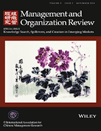
Tips for Choosing Appropriate Level of Abstractions (especially for Chinese Researchers)
A lot of Chinese researchers simply want to imitate how top American journals in formulating theories without boundary conditions. This sounds like doing good science but more often its leads to superficial analyses that do not explain what is happening in China. I was asked to write a commentary on an article by Child and Marinova (2014) in Management and Organization Review and this gave me a chance to reflect more broadly on choosing the appropriate level of abstraction in social science Research. The article is now published.
Reflections on Choosing the Appropriate Level of Abstraction in Social Science Research. 关于在社会科学研究中选择适当的抽象水平的反思
Abstract: Although researchers often do it subconsciously, every explanation involves choosing a level of abstraction at which the argument proceeds. The dominant North American style of research in Organization Theory, Strategy, and International Business encourages researchers to frame their explanations at the highest level of abstraction where country-level contextual factors are suppressed or ignored. Yet to provide powerful explanations for recent developments in China, researchers are drawn to a greater level of context specificity. This tension is evident in the Child and Marinova (2014) paper. One way to reduce the tension is to identify general causal mechanisms that combine in different ways to produce different results depending on context. This research strategy is more effective than seeking invariant, general patterns of development across all times and places.
Keywords: choosing level of abstraction;philosophy of social science;research design;research on industries;research on firms 选择抽象的水平;社会科学的哲学;研究设计;行业研究;企业研究

Categories: China | Entrepreneurship | Publications |

The role of home country demand in the internationalization of new ventures
My article with Salih Ozdemir and Deepak Sardana was just published in Research Policy.
Abstract: International new ventures (INVs) have been documented to exist all around the world, but the literature is silent on the frequency of such companies in different countries. We contend that the propensity of new ventures to internationalize by forming international partnerships is higher in small-domestic demand countries because they have a greater motivation given their limited local demand. After discussing the methodological challenges in testing this hypothesis, we do such a test by studying alliances in the health segment of the biotech industry in relatively small-domestic demand countries (Australia, Israel, and Taiwan) and by comparing the results with five large-domestic demand countries (UK, Germany, France, US, and Japan). We find that young firms in the countries with smaller domestic demand are at least 3 times more likely to enter into international partnerships than their counterparts in countries with larger domestic demand. We further demonstrate that this difference can primarily be explained by the difference in the size of domestic healthcare markets rather than other underlying opportunity structure related factors.
Keywords: International new ventures; Internationalization; Small vs. large demand countries; Young biotechnology firms; International partnerships; Business development partnerships

Read and Download Full Article here
Categories: Entrepreneurship | Innovation | Publications |

Tesco Business Model in Trouble
The economist reports on the trouble of Tesco as UK consumers shopping habits change and the German discounters Aldi and Lidl roll our their operational models in the UK.
By any measure the figures were eye-popping, worse even than most analysts had expected of the struggling company. Tesco made the largest pre-tax loss, of £6.4 billion ($9.6 billion), in British retail history, eight times as much as the previous record, set by Morrisons last year. This was also the sixth-largest loss in the country’s corporate history. Most of it (about £4.7 billion) was due to a fall in the property value of Tesco’s British stores. This was not merely an accounting matter, but a sign of how its out-of-town hypermarkets have fallen out of favour with consumers who shop online or use smaller convenience stores. Underlying profits were 68% down on the previous year, at £961m, and overall sales were down by 1.8%. The stock that Tesco keeps in its warehouses is worth £570m less than previously thought, and the pension scheme is £3.89 billion in deficit. And so on.
Full Story on Economist.com
Categories: Strategic Management 4 | Topics | New Business Model |

Gerhard Steidl’s Fundamental Objective for his Printing Business
Gerhardt Steidl was asked: Many people call you the “king of printing” and some artists will trust no one else with their books. In what way are Steidl’s books different than other books?
He replied:
Most of the publishing houses in the world are owned by shareholder companies and their interest is to make profit. My publishing house is a private business. I founded it in 1968 and it is still owned by me. It is a family business. It is a Manufaktur and we don’t set any limits on cost. A Steidl book is always made in Germany, in Göttingen, in Düstere Straße 4 and there is a guy, Gerhard Steidl, who is hands on. So, believe it or not, I oversee every sheet that tumbles out of our press. This craftsmanship and this know-how we bring to every one of our babies, our books, makes a huge difference compared to the production processes of other companies.
Source: The Talks
Categories: Strategic Management 1 | Topics | Fundamental Objective | Strategic Management 4 | Topics | Fundamental Objective |

Short Case Study of Oracle’s Transformation
The Arc of Company Life - and How to Prolong it provides a good story case illustration using the transformation of Oracle
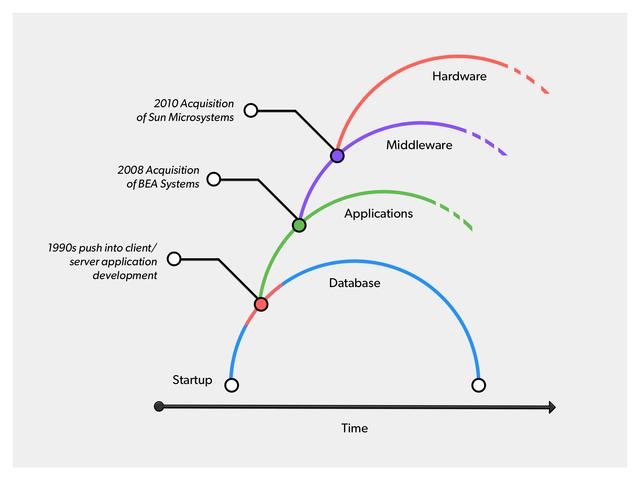
Categories: Strategic Management 4 | Topics | New Business Model |

CEO of Qantas highlights that some private investors explicitly do not focus on financial returns but on social impact. This is called impact investing.
Joyce writes on LinkedIn: It’s not a well-known term in Australia, perhaps because our economic prosperity makes it seem less relevant. But the impact investment market here is growing, targeting areas of social disadvantage that government funding alone can’t fix, from unemployment to homelessness. The point of difference is that an investment relationship requires much more sustained engagement between the investor and the business they’re supporting, compared with a one-off donation or grant.
Indigenous businesses have a particular interest in the potential for impact investment. The Forrest report found that Indigenous enterprises are 100 times more likely to employ Indigenous Australians than other businesses, so building the capacity of these enterprises is vital. Organisations like the CAPE Fund in Canada and Indigenous Business Australia show the way forward, and Qantas is playing a role through our Reconciliation Action Plan, partnerships with Career Trackers and Supply Nation, and backing for ventures such as the North Kimberley carbon offset project.
To read more about impact investing on the Inside Policy blog, click here, and to read John Simon’s landmark report, More than Money, click here.
Categories: Strategic Management 1 | Topics | Fundamental Objective |

Murmann Lecture: What constitutes a compelling case study?
I gave a 50-min keynote lecture on what constitutes compelling case study. The video from the event at the Forum for Case-based and Qualitative Research in Business Administration may be useful for anyone who is attempting to publish case based studies in field of management.
The slides from the lecture are visible in the video and can also be downloaded here. Murmann Slides
The lecture is also available within China on the youku platform. Click here if you want to access video from China: China Video Access. Alternative China Video Access
Click on “more” for a written summary of lecture both in English and in Chinese.
Categories: Lectures |

Getting a better sense of just how small a nanometer is
I am doing a bit of research on history and prospects of nano technology. Since 2000 the US government has an a nano technology initiative to ensure that the country stays what people consider a radical new technology to create new materials and structures. The chips in our computers and smartphones are getting ever more powerful because engineers are able to use nano technology to pack ever more transistors onto a chip. In addition to providing useful short history of nanotechnology, Nano.gov gives an useful illustration just how small is “nano”?
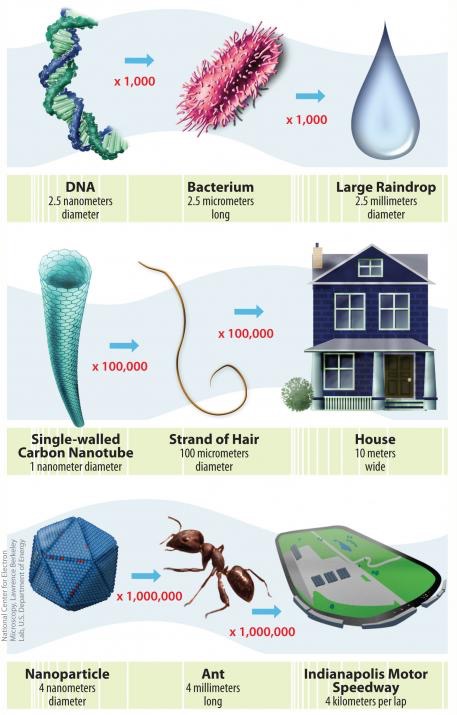
Categories: Innovation |

Bookshops are closing, here is new business model for a pop-up bookshop
I have seen a lot of bookshops go out of business, including the famous bookshop on Telegraph Avenue in Berkeley. From Adelaide comes a new business model for having a physical bookshop that moves to different locations in the city. A pop-up bookshop. The owners write:
Curating an ever-evolving, eclectic mix of old, new and collectible books (in itself somewhat out of step), we’ve popped up in various locations, in various styles, within Adelaide’s CBD. On the street, at boutique markets, in cafes, empty shopfronts, arcades. The idea being that by putting ourselves in plain view, we remind people that bookshops exist.
Well, that’s our story too. In November 2013, we pushed ourselves by leasing a space on Adelaide’s main retail strip, Rundle Mall. Next door to French Connection, across from Nespresso, sharing mall frontage with Apple and Nike. It was a make-or-break philosophy – and we received the most amazing reactions from the public who just couldn’t believe what they’d stumbled upon. It lasted four months and we were encouraged enough by that success to give Rundle Mall another go this year. We’re putting a bookshop on the main stage in a city where people constantly – interminably to us – decry the fact there are “no bookshops in Adelaide”.
But how can this work? Our bookshop is a business. Businesses survive by making money. Bookshops don’t make enough money to pay big rents. All these statements are true, more or less. All we have is a complete, unfaltering faith that what we’re doing is worthwhile and important and, because of this, we’ll be OK.
At the moment, we sell just enough books to pay our wealthy landlord, buy stock and cover our modest living expenses. It’s long hours, risky and stressful but we love it. We need to make money to survive but aren’t driven by money. In fact, the short answer to the “how can it work?” question is that we sacrifice money for lifestyle. We treat it as a seasonal occupation, working unsustainably hard for a short period of time then taking a break.
Full Story in the Guardian
Categories: Strategic Management 4 | Topics | New Business Model |

Carol Dweck: Differences between Growth and Fixed Mindsets
Carol Dweck has spent her career studying how personality traits impact life outcomes. Here is it summarized into one chart.

You can see a larger image by clicking here: Full Size Image
Categories: Management | Psychology |

Fundamental Redesign of CIA Organizational Structure
The director of CIA has decided to that CIA needs a radical overhaul of its structure. The NY Times reports:
Drawing from disparate sources — from the Pentagon to corporate America — Mr. Brennan’s plan would partly abandon the agency’s current structure that keeps spies and analysts separate as they target specific regions or countries. Instead, C.I.A. officers will be assigned to 10 new mission centers focused on terrorism, weapons proliferation, the Middle East and other areas with responsibility for espionage operations, intelligence analysis and covert actions.
During a briefing with reporters on Wednesday, Mr. Brennan gave few specifics about how a new structure would make the C.I.A. better at spying in an era of continued terrorism, cyberspying and tumult across the Middle East. But he said the current structure of having undercover spies and analysts cloistered separately — with little interaction and answering to different bosses — was anachronistic given the myriad global issues the agency faces.
During his two years as C.I.A. director, Mr. Brennan has become known for working long days but also for being loath to delegate decisions to lower levels of C.I.A. bureaucracy. During the briefing on Wednesday, he showed flashes of frustration that, under the C.I.A.’s current structure, there is not one single person in charge of — and to hold accountable for — a number of pressing issues.
Source: NY Times
Categories: Strategic Management 2 | Topics | Organization Structure |

Australia Post Swings to Losses in first time in 30 years
The Guardian reports on the problems of the existing business model:
Australia Post has warned its losses will amount to $6bn over the next 10 years unless the government allows it to change the price of sending letters.
The national carrier is forecasting its first full-year loss in 30 years, or since before it was corporatised.
Its chief executive, Ahmed Fahour, said Australia Post had a competitive parcel business, but losses from its letters business were swallowing up profits.
Fahour said the government understood the scale of the problem. “They either fund the next 10 years of losses, which could amount to $6bn, or we’re out of business,” he told Fairfax radio on Monday.
Australia Post reported a first-half profit after tax of $98m, down 56% on the first-half result of the previous year.
The letters business lost $151m, 57% worse than the loss in the first half of last financial year.
Fahour said Australia Post had never been subsidised and had always paid dividends to the government, but the world had changed.
“Either we get a massive injection from the government to keep the business going, or they give us the permission to manage the business and therefore no subsidy is required and the business can continue,” he said.
Letter volume decline accelerated to 8.2% year-on-year, the largest fall recorded since Australia Post’s letter volumes started falling in 2008.
Categories: Strategic Management 4 | Topics | Disruptive Innovation | New Business Model |

A Good Strategy is like a Good Story


In this context this quote by Jim March also is relevant:
“Leadership involves plumbing as well as poetry.”
Categories: Strategic Management 1 | Topics | Communication | Strategic Management 4 |

Fairfax had trouble financing existing newspaper operations
The Guardian provides an update on how Fairfax, a company we features in our course 7 years ago, is doing:
Hywood counters by claiming that readership has never been higher – Fairfax’s website is the most popular news site in the country, and a barely-believable 5.1 million visitors access it every month. However, this is missing the point.
It is not readers, it is revenue that is needed to run those great full-service newsrooms. And cut-throat competition has driven online advertising through the floor – for every dollar a newspaper loses in print advertising it is lucky to recoup 10 cents online. Few newspapers are lucky enough to be owned by a trust, rather than accountable to shareholders, like the Guardian, or to attract a fairy-godfather like Amazon’s Jeff Bezos, who has adopted the Washington Post.
Hywood’s solution has been to diversify into a dozen different fields. Fairfax’s metropolitan newspapers now produce less than half its revenue. The company has morphed into selling baby goods, organising fun runs and ocean swims, a dating service, a real estate site. It has partnered with Channel Nine to launch a video-to-the-home service, though many fear this will end in tears. Apart from its unlikely name of Stan, it is about to face formidable competition from the world’s largest and most aggressive player in video-streaming, the US giant Netflix, which launches in Australia next month.
But many fear these ventures are just postponing the inevitable demise of the newspapers that have chronicled the country since the earliest days of white settlement, leaving Murdoch, at least for now, with a monopoly on everything Australians read in print. “They’ve saved the company, but f——d the papers,” as one analyst told me.
Categories: Strategic Management 4 | Topics | Economic Logic Analysis | New Business Model |

Useful if you consider submitting to AMJ: Editorial Statement by Current Editor of AMJ
I just read the editorial statement of the current editor of AMJ. If you would like to write about big problems that managers are facing in a scholarly way, AMJ may be a great outlet.
Gerry George writes:
A compelling way to frame a study for theoretical contribution is by asking questions on important anomalies or patterns that are intriguing, useful, and nonintuitive. In an earlier editorial with Jason Colquitt, I suggested that we need to explore “Grand Challenges” in management (see the June 2011 “From the Editors” [vol. 54: 432–435]). The principle is to pursue bold ideas and adopt less conventional approaches to address significant, unresolved problems. Not all our studies understandably will be grand, nor will they all challenge conventional wisdom, but considering the relative importance and scale of a problem will likely make a study more relevant to managers, and make it more interesting for our readers. There are multiple ways by which manuscripts can be better positioned for a theoretical and empirical contribution using a problem focus (Alvesson & Sandberg, 2011; Pillutla & Thau, 2013; also see the October 2011 “From the Editors” [vol. 54: 873–879]). What is important to recognize is that this team places emphasis on how a central research problem or question is articulated. Bringing organizational problems to the forefront would ease the burden on vaguely scripted “Managerial Implications” sections of manuscripts (Bartunek & Rynes, 2010).
My editorial team will look for clearly articulated problem statements or research questions motivated by managerial challenges. This problem-based focus shifts the emphasis away from motivating articles using pure theories to tackling important problems through an enriched theoretical lens. For example, Hekman and colleagues (Hekman, Aquino, Owens, Mitchell, Schilpzand, & Leavitt, 2010) motivate their study on gender and racial biases in customer satisfaction surveys by emphasizing the importance of the managerial problem that a 1 percent change in customer satisfaction creates a 5 percent change in return on investment. Understanding the scale and scope of the problem and asking the right question takes primacy over the deftness of theoretical manipulation using constructs, moderators, and moderated mediators. We prefer manuscripts that emphasize how constructs provide a coherent explanation of the phenomenon rather than framing and motivating studies by adding untested moderators and mediators. Such an effort would rightly dissuade authors from identifying smaller “gaps” in the literature and shift the discussion to managerial, organizational, and societal problems that need to be addressed.
Categories: Management | Writing |

Superb Example of Strategy Process Research: New Paper by Laurent Mirabeau and Steve Maguire in SMJ
I just read a fantastic research paper that I recommend highly to anyone who is interested in strategy process research.
Mirabeau, L., & Maguire, S. 2014. From autonomous strategic behavior to emergent strategy. Strategic Management Journal, 35(8): 1202-1229.
The authors do wonderful job first summarizing the different strands in strategy process research. Then they present new findings on how autonomous strategic initiatives become emergent strategy. They introduce the new idea of Ephemeral Autonomous Behavior to balance out the traditional Mintzberg model of emergent strategies. I have added the paper to my list of exemplary case studies worthy of imitation.
The core of the paper is nicely summarized in these two figures.
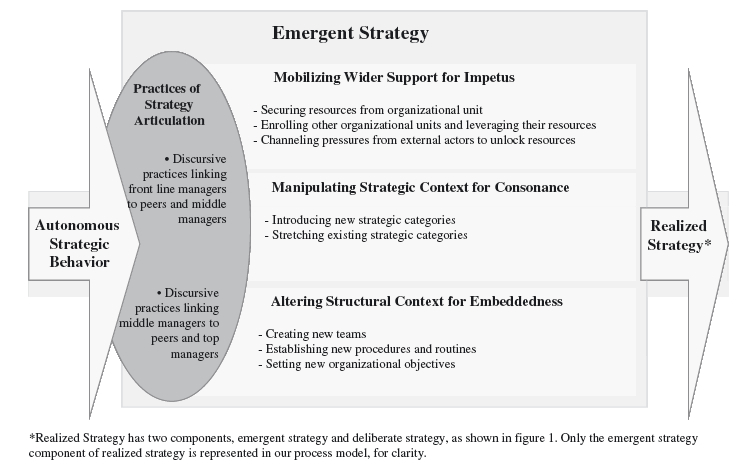
(Right click on each figure to open it in a larger format on a new page.)
Categories: Management |
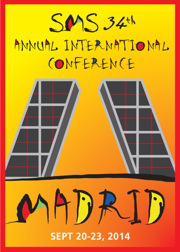
Will give two presentations at Strategic Management Conference in Madrid, Sep 21-22
1. The Strategic Process and Competitive Dynamics of Industry Convergence
Date: Sunday, September 21, 2014
Time: 11:15 – 12:30
Room: Viena
Session Co-Chairs:
Samina Karim, Boston University
John Prescott, University of Pittsburgh
Panelists:
* Alfonso Gambardella, Bocconi University
* Anita McGahan, University of Toronto
* Johann Peter Murmann, University of New South Wales
* Fernando Suarez, Boston University
Understanding how industries change has attracted considerable attention because it blurs industry boundaries, redefines the competitive landscape, creates opportunities for new strategies to emerge, destroys competitive advantages while solidifying others, challenges cognitive maps and establishes new institutional arrangements. In this session, expert panelists will bring us up-to-date on the phenomenon of industry convergence (IC) by sharing their perspectives regarding (1) the antecedents, dynamics, and consequences of IC; (2) how to conceptualize strategic management processes and how they may inform the dynamics of IC; (3) how scholars should evaluate the attractiveness of, and rivalry within, IC industries; and (4) promising research directions including theory development and empirical studies.
Categories: Conferences |

Who Matters More? The Impact of Functional Background and Top Executive Mobility on Firm Survival
Do some top executives matter more than others? Integrating insights from upper echelons and executive mobility research, we suggest that the functional roles performed by top executives shape their value to the firm. We examine the effects of inter-firm executive mobility on firm survival for New York City advertising firms from 1924 to 1996. We find that, while losing any top executive is damaging, the loss of a top executive whose functional role focuses on internal firm processes is more detrimental to firm survival than losing a top executive whose functional role focuses on managing external exchange relationships. Additionally, in situations when multiple executives leave simultaneously, firms are more negatively affected when the group departing is functionally heterogeneous.
Bermiss, Y. S., & Murmann, J. P. 2014. Who Matters More? The Impact Of Functional Background And Top Executive Mobility On Firm Survival. Strategic Management Journal:
An earlier version that placed more emphasis on heterogeneity of top management teams influencing firm survival is available at SSRN.

Laptops are a big distraction in the class room
I am inconsistent. I some contexts I have banned computers and more importantly smartphone use in classrooms because it became apparent that large number of students were distracted by it. It others I have allowed it because I myself like to take notes on a laptop. Here is the evidence why at least internet connections need to be turned off in classrooms.
Over time, a wealth of studies on students’ use of computers in the classroom has accumulated [...]. Among the most famous is a landmark Cornell University study from 2003 called “The Laptop and the Lecture,” wherein half of a class was allowed unfettered access to their computers during a lecture while the other half was asked to keep their laptops closed. The experiment showed that, regardless of the kind or duration of the computer use, the disconnected students performed better on a post-lecture quiz. The message of the study aligns pretty well with the evidence that multitasking degrades task performance across the board.
Pop quizzes, of course, are not the best measure of learning, which is an iterative and reflective process. Recent Princeton University and University of California studies took this into account while investigating the differences between note-taking on a laptop and note-taking by hand. While more words were recorded, with more precision, by laptop typists, more ended up being less: regardless of whether a quiz on the material immediately followed the lecture or took place after a week, the pen-and-paper students performed better. The act of typing effectively turns the note-taker into a transcription zombie, while the imperfect recordings of the pencil-pusher reflect and excite a process of integration, creating more textured and effective modes of recall.
Categories: Lectures | Psychology |

Abstract: Building on recent research on dynamic, high-growth firms—so-called “gazelles”—this paper explores a simple question that is important in both theoretical and practical terms: What is the fastest rate at which firms can grow? Based on a sample of seven high-growth firms (Cisco, GM, IBM, Microsoft, Sears, Starbucks, and US Steel), we find that 162% is the maximum sales growth rate in any one year that an established company can grow without mergers and acquisitions, while the maximum rate of employee growth is approximately 115% even including some mergers and acquisitions. All of the companies in our sample attained a maximum sales growth rate of above 50%, with most hovering around 75%. Furthermore, the firms’ growth rates exhibit similar patterns. No company experienced its maximum sales growth rate toward the latter part of its history. Every company experienced its slowest employee growth rate after attaining its maximum employee growth rate, usually within a decade of one another. Most importantly, all firms show an average sales growth that exceeds the average employee growth. This finding is an indication that successful growing firms have a superior capability to continuously improve employment efficiency and adjust organizational structures to suit an increasing workforce.
Murmann, J. P., Korn, J., & Worch, H. 2014. How Fast Can Firms Grow? Journal of Economics and Statistics (Jahrbuecher fuer Nationaloekonomie und Statistik), 234(2-3): 210-233. Download Article
Categories: Management |
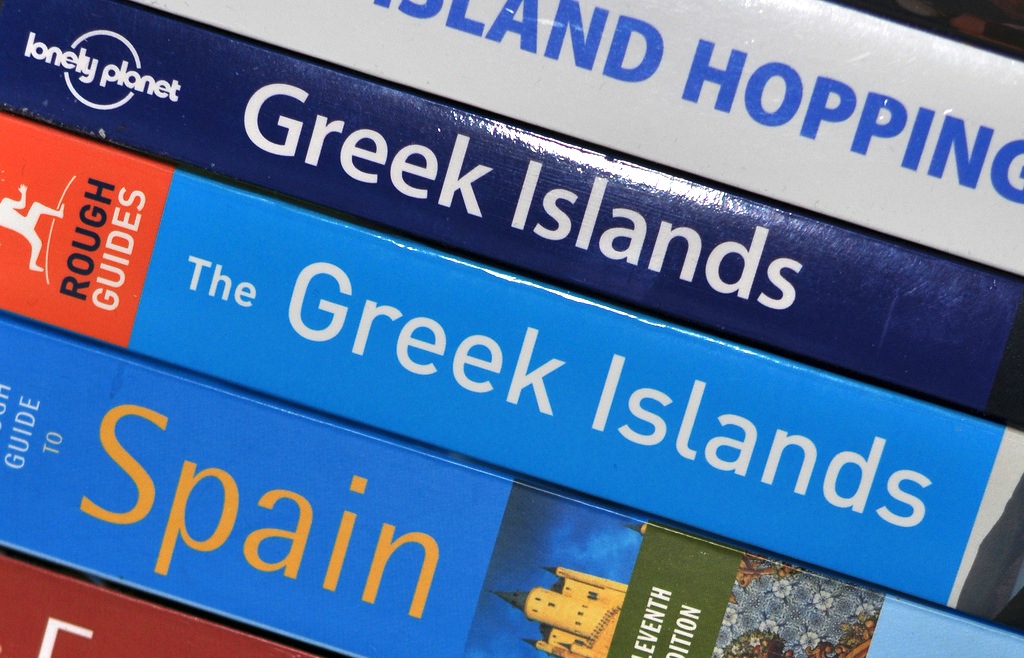
The Rapid Decline of Printed Guidebooks
The digital revolution is devouring printed travel guides. Lonely planet is a case in point. The BBC bought the company forf $210 in 2007 and sold it last year for roughly $121 million. Here is a instructive figure charting the decline in printed guide sales.
Lonely Planet and the rapid decline of the printed guidebook
Categories: Strategic Management 4 | Topics | Disruptive Innovation |

CEO of Large German Publisher speaks out: Why we fear Google
This if one of the most interesting open letter I have ever read by a CEO. Mathias Döpfner, CEO of Axel Springer, closes his open letter:
Dear Eric Schmidt, you do not need my advice, and of course I am writing here from the perspective of those concerned. As a profiteer from Google’s traffic. As a profiteer from Google’s automated marketing of advertising. And as a potential victim of Google’s data and market power. Nevertheless – less is sometimes more. And you can also win yourself to death.
Historically, monopolies have never survived in the long term. Either they have failed as a result of their complacency, which breeds its own success, or they have been weakened by competition – both unlikely scenarios in Google’s case. Or they have been restricted by political initiatives. IBM and Microsoft are the most recent examples.
Read full letter in FAZ: Why we fear Google
Categories: Innovation | Economics |

What Employers value the most in MBA graduates
A recent survey of CEOs reveals what they are looking for in today’s MBA graduates:
Self-Awareness (62%)
Integrity (60%)
Cross-Cultural Competency (57%)
Team Skills (49%)
Critical Thinking (48%)
Communication (48%)
Comfort with Ambiguity and Uncertainty (41%)
Creativity (27%)
Execution (21%)
Sales (19%)
Source: PoetsandQuants.com
Categories: Management |

Another Great Example of Serendipity in Scientific Discovery
People underestimate that scientists often make progress by chance. Here is the story of researchers studying a species that has invaded Florida’s Everglades made an unanticipated discovery: deadly Florida pythons have internal GPS.
“We found that Burmese pythons have navigational map and compass senses,” said Shannon Pitman of North Carolina’s Davidson College, the lead researcher of a team of scientists that released six captured snakes back into the wild, then tracked them through the Everglades National Park for up to nine months.
“It wasn’t what we expected. We thought we’d see a kind of aimless, wandering behaviour, but the pythons made their way pretty quickly back to where to where they were captured. It was more sophisticated in terms of movement than we’ve seen in other species of snake.”
What makes the discovery more remarkable is that it was completely accidental. Pitman’s team originally wanted to release the snakes closer to their capture points within the Everglades, as they were more interested in studying the habitat through which they were moving than the actual distances they travelled.
But wildlife officials, whose efforts to eradicate or contain the up to 100,000 non-native snakes estimated to have spread through the park’s 1.5m acres, refused permission.
That led to the team releasing the snakes at more remote locations between 13 and 23 miles away, outside the National Park’s boundaries, and then watching in amazement as one python after another made its way back “home”.
Each snake was fitted with a radio tracker and its position monitored by GPS one to three times per week. All six moved in a near-straight line towards their capture points and five ended up within a couple of miles. The snake with the longest journey took nine months to reach its destination.
Full Story: Guardian
Categories: Methodology |

Superb Video Illustration of Changes to USA Budget in the past 50 Years

Click on “More” to play the video animation.
Categories: Economics |


